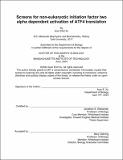| dc.contributor.advisor | Weissman, Jonathan S. | |
| dc.contributor.author | Xu, Acer Eliot | |
| dc.date.accessioned | 2024-06-27T19:45:24Z | |
| dc.date.available | 2024-06-27T19:45:24Z | |
| dc.date.issued | 2024-05 | |
| dc.date.submitted | 2024-05-17T16:34:56.467Z | |
| dc.identifier.uri | https://hdl.handle.net/1721.1/155330 | |
| dc.description.abstract | Cells must be able to respond to their environment. Inability to respond correctly to changes has direct consequences on cellular fitness. Eukaryotic cells have developed many different pathways to signal nutrient availability, cellular stress, and general environmental changes in order to maintain homeostasis, accumulate biomass, and divide. Less is known about how these signaling pathways overlap and interact to produce complex cell phenotypes. Here, I investigate these questions using two models of eukaryotic cell stress: the integrated stress response (ISR) and mammalian target of rapamycin (mTOR) pathway in H. sapiens, and the environmental stress response (ESR) and heat shock response (HSR) in S. cerevisiae. I first establish a CRISPRi screening competent human cell line incapable of activating the ISR. Using genome-wide genetic screens of this cell line, I show that the gene CARS1 represents a previously unknown pathway for activation of ATF4 translation that does not require phosphorylation of the classical ISR affector molecule eIF2α. I also show that mTOR signaling is not necessary for this activation of ATF4, and that this pathway is modulated by the genes METAP2 and OGT. Next, I study overlap between the ESR and HSR to show that the ESR acts as a suppressor of Hsf1 activity in aneuploid yeast. We show that the ESR is cytoprotective and that active Hsf1 cannot compensate for loss of the ESR. We also show that ESR activation in aneuploid yeast is cytoprotective. These studies highlight the complexity of regulation between various signaling pathways in eukaryotic cells, define a novel pathway for regulation of cell state, and demonstrate that there are additional unexplored signaling pathways, the mechanisms of which still remain unclear. | |
| dc.publisher | Massachusetts Institute of Technology | |
| dc.rights | In Copyright - Educational Use Permitted | |
| dc.rights | Copyright retained by author(s) | |
| dc.rights.uri | https://rightsstatements.org/page/InC-EDU/1.0/ | |
| dc.title | Screens for non-eukaryotic initiation factor two alpha dependent activation of ATF4 translation | |
| dc.type | Thesis | |
| dc.description.degree | Ph.D. | |
| dc.contributor.department | Massachusetts Institute of Technology. Department of Biology | |
| mit.thesis.degree | Doctoral | |
| thesis.degree.name | Doctor of Philosophy | |
